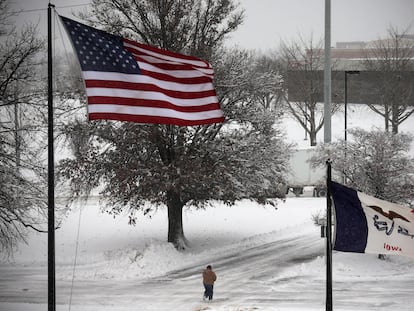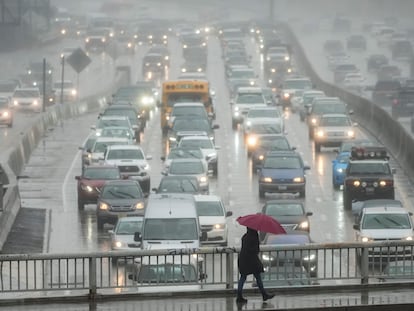Polar vortex: what is it and how it influences cold weather in the US
Northern states have experienced extremely low temperatures lately which has been credited to a disrupted polar jet stream, a periodic weather phenomenon that can push freezing air south

As the United States faces extremely low temperatures, some weather commentators are mentioning the polar vortex, an area of rotating winds in the Arctic. They say a possible disruption in its system could be responsible for colder winds in the northern states of the country.
What is the polar vortex?
The Arctic polar vortex is a band of winds that forms in the stratosphere between “about 10 and 30 miles above the North Pole every winter”, according to the National Oceanic and Atmospheric Administration. Those winds enclose a large amount of extremely cold air, which gets colder if the winds get stronger as the air inside is isolated from warmer latitudes. While it weakens during the summer, it becomes stronger in wintertime. The National Weather Service says that it’s called a vortex because of the “counter-clockwise flow of air that helps keep the colder air near the Poles”. Not all cold weather comes from the polar vortex, as the cold air typically is kept in the polar regions and it takes “unusual conditions” for the flow to migrate far south.
Many times during winter, as the polar vortex expands, it sends cold air southward with the polar jet stream, which is associated with the large outbreaks of cold Arctic air in the U.S. The jet stream occurs in the troposphere, which is 5 to 9 miles above Earth’s surface. While some credit the polar vortex for the weather, “it’s the polar jet stream that plays a big role in our day-to-day winter weather”, according to NOAA.
The cold air from the jet stream not only causes an increase of cold air in the U.S but also Canada (obviously) and parts of Europe and Asia. When the vortex is strong, it keeps the jet stream balanced around the Earth, making weather work “normally”. However, when the vortex gets disrupted and weakens, the system can break off, pushing cold air down south, causing colder weather in northern regions.
Some scientists have highlighted that recent climate change in the Arctic is disrupting the polar vortex, causing more cold air to enter the U.S.. Kristina Dahl, scientist at the Union of Concerned Scientists, told Scientific American that the fact that 2023 was the hottest year on record could be linked to increasing cold temperatures: “Climate change is causing all sorts of different impacts and some of them are counterintuitive”. Some studies have shown this type of connection with cold winters in North America. However, other experts cast doubt on this theory saying that there is not enough evidence to confirm it, and yet other studies have suggested that the ice loss caused by global warming could lead to a stronger polar vortex.
Polar vortex in 2024
The United States is currently experiencing an intense cold snap due to the first significant Arctic air mass of 2024. According to meteorologist Laura Ciasto and weather scientist Amy Butler from NOAA, the stratospheric polar vortex has shown unusual behavior, with a minor disruption closer to the stratosphere-troposphere boundary, resulting in the splitting of the vortex into two lobes. The disturbance in the lower stratosphere has already contributed to a cold air outbreak over North America. While the full breakdown of the polar vortex is expected to be brief, the effects on the tropospheric jet stream and weather patterns could persist, increasing the likelihood of cold air outbreaks in the coming weeks. The experts highlight that the polar vortex is one of several factors influencing weather, and other elements like El Niño also play a role.
Sign up for our weekly newsletter to get more English-language news coverage from EL PAÍS USA Edition
Tu suscripción se está usando en otro dispositivo
¿Quieres añadir otro usuario a tu suscripción?
Si continúas leyendo en este dispositivo, no se podrá leer en el otro.
FlechaTu suscripción se está usando en otro dispositivo y solo puedes acceder a EL PAÍS desde un dispositivo a la vez.
Si quieres compartir tu cuenta, cambia tu suscripción a la modalidad Premium, así podrás añadir otro usuario. Cada uno accederá con su propia cuenta de email, lo que os permitirá personalizar vuestra experiencia en EL PAÍS.
¿Tienes una suscripción de empresa? Accede aquí para contratar más cuentas.
En el caso de no saber quién está usando tu cuenta, te recomendamos cambiar tu contraseña aquí.
Si decides continuar compartiendo tu cuenta, este mensaje se mostrará en tu dispositivo y en el de la otra persona que está usando tu cuenta de forma indefinida, afectando a tu experiencia de lectura. Puedes consultar aquí los términos y condiciones de la suscripción digital.
More information
Últimas noticias
The Iberian Peninsula is rotating clockwise, scientists report
Louis Tomlinson on surviving the loss of his mother, sister and One Direction bandmate: ‘There’s no preparation for what I’ve been through’
Media and political earthquake in Italy over sale of ‘La Repubblica’ and ‘La Stampa’, the two main opposition newspapers
Does someone decide what we listen to? How Spotify’s algorithm works and what we know about its real power
Most viewed
- Christian Louboutin: ‘Young people don’t want to be like their parents. And if their parents wear sneakers, they’re going to look for something else’
- ‘We are dying’: Cuba sinks into a health crisis amid medicine shortages and misdiagnosis
- A mountaineer, accused of manslaughter for the death of his partner during a climb: He silenced his phone and refused a helicopter rescue
- Cartels in Mexico take a leap forward with narco-drones: ‘It is criminal groups that are leading the innovation race’
- If AI replaces workers, should it also pay taxes?











































